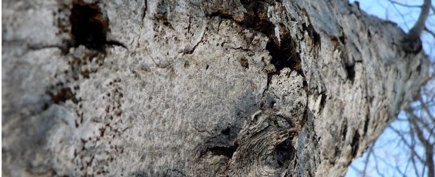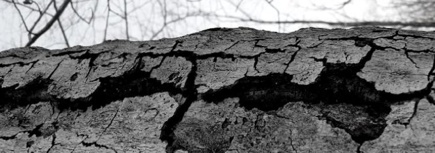 An interesting thing about living in a mixed-deciduous forest is that it can look very different depending on the season. Winter’s loss of leaves can bring more subtle differences like a tree’s bark into focus, and even the most minute variation in bark structure can jump out at you when treebark is the most common thing seen. The shaggy, rough bark of a hickory, the scaled surface of a black cherry, and the smooth surface of beech trees all spark a contrast against a sea of red maple. Yet, there’s something strange lurking in Sapsucker Woods, systematically infecting beech trees and destroying them from within…
An interesting thing about living in a mixed-deciduous forest is that it can look very different depending on the season. Winter’s loss of leaves can bring more subtle differences like a tree’s bark into focus, and even the most minute variation in bark structure can jump out at you when treebark is the most common thing seen. The shaggy, rough bark of a hickory, the scaled surface of a black cherry, and the smooth surface of beech trees all spark a contrast against a sea of red maple. Yet, there’s something strange lurking in Sapsucker Woods, systematically infecting beech trees and destroying them from within…
A few weeks back I listened to Julie Zickefoose on NPR’s All Things Considered reminisce about an old beech tree on her property. She recounted a bit of wisdom from her father, that “a tree spends its first 50 years growing, the second 50 years living, and its last 50 years dying”. Here in the Sanctuary that lifespan is being shortened — not by unscrupulous name-carvers, or tree-poachers, or even a herd of ravenous beavers. In fact,  the culprit in this infestation is small enough that you probably wouldn’t even notice it if it weren’t for the pockmarks and fractures that blanket adult beech trees. Even its name portends a sinister (yet accurate) demise: Beech Bark Disease (at least it’s one of those disease names that actually tell you something about the disease).
the culprit in this infestation is small enough that you probably wouldn’t even notice it if it weren’t for the pockmarks and fractures that blanket adult beech trees. Even its name portends a sinister (yet accurate) demise: Beech Bark Disease (at least it’s one of those disease names that actually tell you something about the disease).
While many of the young trees have yet to become visibly infected, most of the adult trees (many of them easily visible from the trail) show the tracks of this disease, a spiderweb of cracks and crevices in the bark, or a near-uniform pattern of circular pockmarks that indicate an earlier stage in the disease. Public Enemy #1 is an invasive beech scale insect from Europe that made its way to North America sometime in the late 1800s. This insect makes a living by channeling the goodness flowing through a beech tree’s bark into its stomach. These injuries to the tree provide entry to a fungus that has always been present in the environment, but lacked the means to get past the smooth bark. Infection leads to severe weakening of the tree, disfigurement, and possible girdling leading to tree death. After consulting two theses done in Sapsucker Woods (from 1950 and 1980), neither of them mentions this exotic invader, suggesting that the infestations began in the last 20 years.Given the commonness of beech trees in Sapsucker Woods, it would be understandable to wonder about the “future” of this woodlot. Plenty of the larger beech trees have already succumbed, their treetops snapped clean, and their interiors the fertile hunting grounds for a number of woodpeckers. It is likely that the number of beech trees will continue to decline until they are much less common in the environment. This is not the first time that a disease has swept this small woodlot: 15% of the trees surveyed in parts of the forest in 1950 were Elm trees, and there is nary an elm today, victims of Dutch Elm Disease outbreaks of the 1950s. You won’t find an american chestnut tree either, thanks to the chestnut blight of the 1920s. And yet the woodland perseveres. All of that standing deadwood is good for something, and it probably explains the persistent presence and species diversity of the 10-15 woodpeckers that visit my backyard. There is hope, too, for the afflicted beech. Natural resistance to the disease has been noted in other populations, and we can keep our fingers crossed that over time these stately old trees remain prolific and seed the woodlands with resistant youngsters.So — on your next walk, keep your eyes out for BBD and say hello to the disappearing beeches…
There is hope, too, for the afflicted beech. Natural resistance to the disease has been noted in other populations, and we can keep our fingers crossed that over time these stately old trees remain prolific and seed the woodlands with resistant youngsters.So — on your next walk, keep your eyes out for BBD and say hello to the disappearing beeches…






It must be difficult to watch. these trees took so long to grow and probably sustain many creatures. A tragedy.
In some ways it is a tragedy, Barbara, but it’s important to remember that all those dead trees feed back into the system: as homes for woodpeckers, chickadees, and barred owls, and as the nutrient foundation for the new generation of vegetation that takes its place. Without the beech trees, the forest lives on (much like the elm and chestnut deletions), and while the pace may seem quickened, it will still be interesting to see what happens next.
Lovely blog (and not just because you speak of fungus). Stay warm, and keep up the good work!